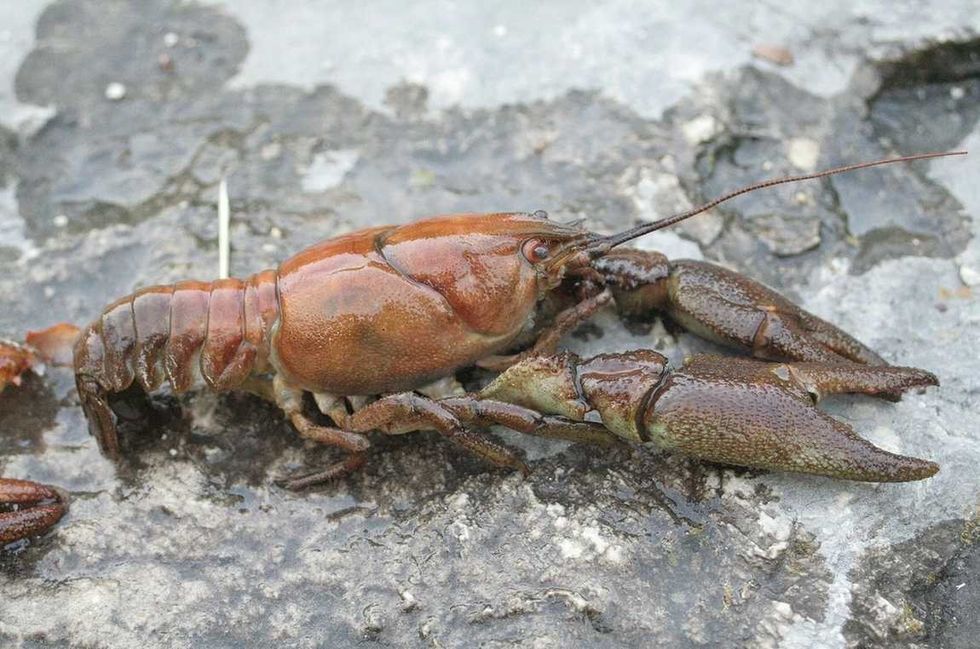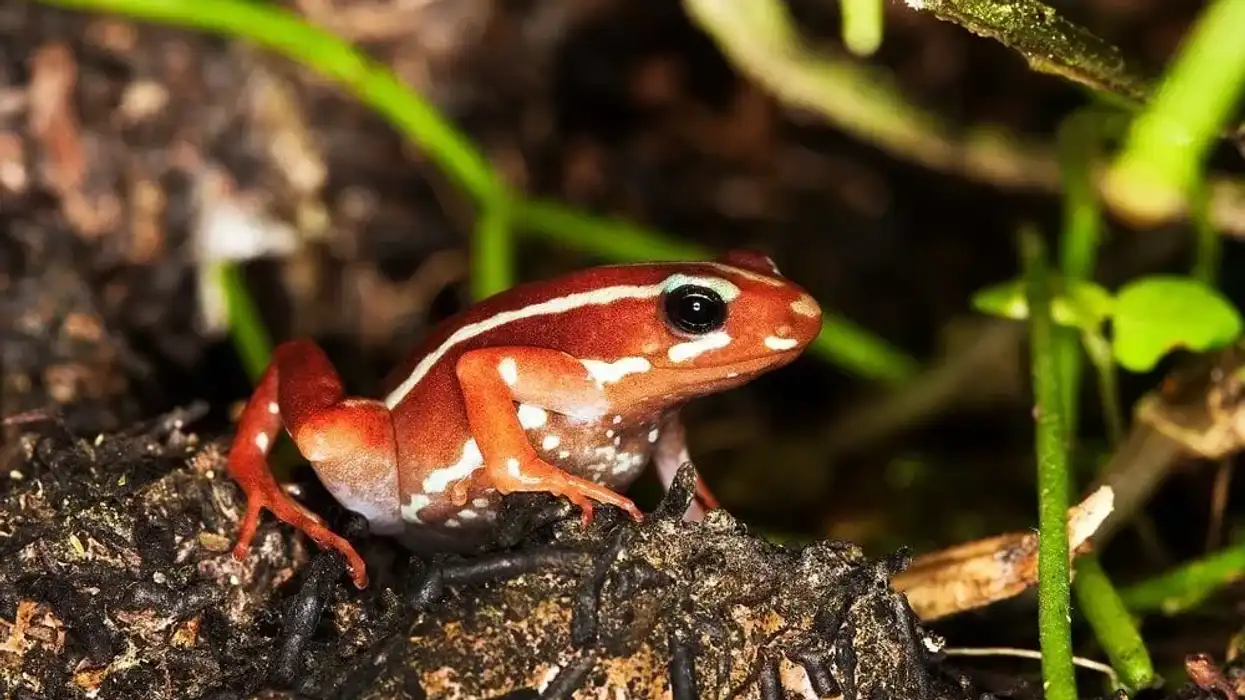Crayfish are a type of freshwater species that are closely related to marine lobsters. Several species of crayfish are distributed throughout the world with seven species belonging to the marine waters of Europe.
The white-clawed crayfish (Austropotamobius pallipes) is one of the seven species of European crayfish and it is the only species of crayfish native to the British Isles. They are also commonly known as Atlantic stream crayfish. These freshwater animals occur naturally in the waters of the United Kingdom and Ireland.
These crayfish are found in many freshwater habitats like lakes, streams, and rivers consisting of a stony substrate, especially limestone substrate. These fish need calcium for the growth and development of their body armor.
At present, the population of these crayfish is threatened on a large scale. The introduction of some non-native crayfish species, like the North American signal crayfish (Pacifastacus leniusculus), in England and Wales has impacted negatively on their population distribution.
This invasion of the non-native signal crayfish species resulted in the spreading a fungal disease called the crayfish plague. Currently, Ireland is solely responsible for the protection and conservation of the white-clawed crayfish populations.
It is the only place without any proven evidence of the incidence of the introduced crayfish plague.
Several research programs in the most vulnerable sites are being conducted to monitor the population of the white-clawed crayfish. To know more about the crayfish, keep on reading these amazing facts.
For similar content check out our marbled crayfish facts and crayfish facts too!
White-clawed Crayfish Interesting Facts
What type of animal is a white-clawed crayfish?
The white-clawed crayfish (Austropotamobius pallipes) is a freshwater species of crayfish. They are a native species of the United Kingdom and Ireland.
What class of animal does a white-clawed crayfish belong to?
The white-clawed crayfish, of the Decapoda order and Astacidae family, belong to the class Malacostraca, the common class for lobsters and crayfish.
How many white-clawed crayfish are there in the world?
The global population of white-clawed crayfish has not been estimated. However, in the past one or two decades, the population of this native crayfish species has declined significantly from their habitat.
Once found abundantly in England, Wales, and Ireland their populations are now threatened by some introduced species in their native range.
At present, Ireland hosts the largest sub-population of freshwater white-clawed crayfish.
Ireland's population was estimated to be around 37,000 adult individuals in White Lake before the plague. A large number of freshwater crayfish also populated the Lough Lene lake.
However, since the onset of the crayfish plague introduced by the invasion of non-native North American signal crayfish species, the White Lake and Lough Lene populations have declined significantly. The reintroduction process in some sites of Ireland is being carried out yet, their populations are slowly declining.
The species of crayfish were widespread throughout most of England for about 500 years prior to the population degradation caused by the non-native crayfish species of America.
It is believed that around 95% of the total populations have now disappeared from their habitats in south and west England, particularly from the tributaries of the Thames river.
These native crayfish were once present in all the major tributaries of the river but currently, they are only present in eight of them. Apart from their native range, the white-clawed crayfish's distribution is also declining in France, Italy, Germany, Spain, and Switzerland as an effect of the crayfish plague.
Where does a white-clawed crayfish live?
The white-clawed crayfish is a native freshwater species in the British Isles. These creatures occurred throughout most of Great Britain in past.
However, currently, the range of the native white-clawed crayfish has declined largely due to the introduction of the invasive North American signal crayfish in their range. They have almost disappeared from the south and west England. Currently, they are recorded from northern and central England, eastern Wales, some parts of Essex, Hampshire, and Kent.
The western range of the crayfish has shortened from the western border of Portugal to the border of Spain. A present, they are found commonly in Ireland.
What is a white-clawed crayfish's habitat?
Their ideal habitat is fast-flowing rivers, freshwater streams, and shallow canals. They are also capable of inhabiting large lakes and ponds.
They prefer to live in sites containing rocky substrates, especially limestone substrate. The crayfish are totally absent from acidic waters with high pH levels.
Hard and calcareous water containing lots of minerals, especially calcium carbonate provides an ideal habitat for the crayfish. These freshwater crayfish need calcium for the growth of the head armor covering their body.
They are shy and elusive in nature and submerged logs, rocks, and tree roots provide shelter to the species. They can also survive in muddy habitats if sufficient tree roots or other woody structures are present.
The animals stay inside burrows of holes carved on the banks of a river during the day and forage for food during the night. Most of their habitats have been invaded by a non-native species called signal crayfish.
Who does white-clawed crayfish live with?
Crayfish are generally solitary animals living alone.
How long does a white-clawed crayfish live?
The lifespan of the white-clawed crayfish ranges between 8-12 years in the wild.
How do they reproduce?
The white-clawed crayfish is a freshwater crayfish living in cool temperate water, they need cold water for spawning. The breeding season of the crayfish starts in the late autumn season in September and ends in December during the early winters.
The optimum temperature of the water should be below 50 F (10 C) to initiate the breeding process in the white-clawed crayfish. The females lay 20-160 eggs in a single clutch per breeding season.
Even after the eggs are laid, they stick under the tail segment of the female crayfish.
The females carry around all the eggs stuck to the tail until they hatch and the juveniles are born. The eggs hatch while they remain stuck to the female's body and the juveniles are born on its body.
Generally, the juvenile crayfish are released by the females after the eggs hatch between June and August. The juvenile crayfish reach sexual maturity after three or four years of age.
What is their conservation status?
The International Union for Conservation of Nature or the IUCN listed the species as Endangered. The white-clawed crayfish IUCN assessment is based on the criteria of declining populations and reduction of available habitat in their native range.
In the last few decades, these animals have lost 50-80% of their total populations in France, England, and Italy.
Their populations are also strongly believed to decline in the other parts of their range but there are no official records of those declines. The primary factor affecting the wildlife is the expansion of non-native invasive crayfish throughout their range, except Ireland where the species could not survive.
The species of crayfish may disappear in the near future if the population data of other countries are not monitored immediately. Another cause because of which the crayfish may decline is the number is damaged habitats.
The wildlife species are very sensitive to chemical pollution.
Overusing chemicals and insecticides in the lakes and rivers of their range dilutes the freshwater ecosystem. A number of national and international ensured white-clawed crayfish protection from their substantial threats to stabilize their population.
White-clawed Crayfish Fun Facts
What do white-clawed crayfish look like?

The appearance of a white-clawed crayfish resembles lobsters. They have an olive-brown upper body while their underparts are pale in color. They have five pairs of legs, the front pair transformed into large claws.
The color of the underside, including the claws, varies from cream to orangey-white. They are given the name white-clawed because of their distinctively colored claws. They are one of the largest invertebrates found in the freshwaters of the UK.
How cute are they?
The white-clawed crayfish's body is covered by armor, therefore their body or face is not visible properly, because of which we do not find them particularly cute.
How do they communicate?
Crayfish communicate in the same way as crabs and lobsters, they emit chemicals through urine which helps in communication.
How big is a white-clawed crayfish?
The length of a white-clawed crayfish ranges between 2.4-4.7 in (6-12 cm). They are smaller in size than a slipper lobster.
How fast can a white-clawed crayfish move?
The speed of a white-clawed crayfish has not been determined.
How much does a white-clawed crayfish weigh?
The white-clawed crayfish can weigh up to 3.2 oz (90 g).
What are the male and female names of the species?
The male and female crayfish do not have any specific names. Both are called white-clawed crayfish.
What would you call a baby white-clawed crayfish?
A baby crayfish is referred to as a hatchling.
What do they eat?
White-clawed crayfish are omnivorous in nature, they also show cannibalism. They feed on plant matters as well as small invertebrates like snails, larvae of insects, and small fish. They are also known to prey upon birds, otters, and rats.
Are they dangerous?
No, they are not dangerous. They can also be eaten as a delicacy.
Would they make a good pet?
It is illegal to pet crayfish in the UK, so they can't be made pets.
Did you know...
White-clawed crayfish are nocturnal in nature, meaning they are most active during the night. They also become highly inactive during the winter season but they do not hibernate.
White-clawed crayfish vs signal crayfish
The white-clawed crayfish and the signal crayfish are two species of crayfish however the former is found in Europe while the latter is found in North America. The signal crayfish is hardier in nature and is immune to a fungal disease called crayfish plague, while the white-clawed crayfish are not.
The invasion of these crayfish in the native range of white-clawed crayfish has made the latter's population unstable.
Why are white-clawed crayfish endangered?
The white-clawed crayfish of the United Kingdom is listed as Endangered in the IUCN Red List. There are two primary factors behind their endangered status.
First is the incidence of an invasive crayfish called the signal crayfish in their range. They have taken over most of their habitat restricting the white-clawed crayfish to a very small region.
In the competition for survival of the fittest, the signal crayfish outcompeted the native crayfish in terms of food and places to live.
Secondly, the white-clawed crayfish fall prey to widespread habitat fragmentation. Loss of suitable habitats in their native range due to river pollution and human developments have degraded the water quality of rivers and affected the populations in a negative way.
Here at Kidadl, we have carefully created lots of interesting family-friendly animal facts for everyone to discover! Learn more about some other fish from our Florida crayfish facts and spiny dogfish facts pages.
You can even occupy yourself at home by coloring in one of our free printable snapper coloring pages.
Main image by David Gerke.
Second image by Gail from Cradley, Malvern.









